Siena
A medieval town universally known for its artistic treasures, located in every corner of the city, and for its Palio, an event that attracts thousands of visitors from all over the world every year.
Since 1995, its historic centre has been a UNESCO World Heritage Site, and with good reason. In the historical centre, important evidence of the Etruscan period has been found, leading to the foundation of the city at that time.
Siena, history and stories
But it was in the late Middle Ages and the Renaissance that Siena, and its namesake Republic, experienced their greatest splendour. Until its fall at the hands of the alliance between the Habsburgs and Medici Florence in 1555, the Republic’s possessions came to encompass almost a third of the territories of present-day Tuscany, and in retrospect it is recognised as the only western state to implement a pure democracy in favour of the people.
 What to visit in Siena
What to visit in Siena
There is a lot of architecture and monuments in Siena, starting with the famous central square, Piazza del Campo, the only example of a shell-shaped square of renowned beauty and architectural integrity.
Here, twice a year, the famous Palio is held, the equestrian competition that pits the Contrade Senesi, the ancient quarters, against each other. The joust is extremely popular in the city, so much so that it monopolises the lives of hundreds of people who prepare for the competitions throughout the year.
Other places of interest include the Duomo di Siena, the metropolitan cathedral of Santa Maria Assunta, an ecclesiastical building built between 1220 and 1370 and located in the square of the same name, which stands out for its Italian Romanesque-Gothic style, making it one of the most representative structures in this style in our territory.
The Baptistery of San Giovanni is also well worth mentioning, being a splendid example of a late Gothic style building by the renowned architect Camaino, with its magnificent white marble façade and inside frescoes on the vaults attributed to the Bolognese painter Agostino di Marsiglio.
Siena’s secular monuments
Among the secular monuments dearest to the citizens of Siena, however, a must is the one leading to the Fonte Gaia, a fountain located in Piazza del Campo, which unfortunately is only a copy of the original, which was characterized by the precious sculptural reliefs created by Jacopo della Quercia and was replaced by the current one, in recent times, because the material used to build it was easily degradable. If you want to see the original, however, it is kept at the Museo di Santa Maria della Scala, a wonderful museum complex located in Piazza del Duomo and containing collections of medieval, Etruscan, Renaissance and contemporary art.
Last but not least, a visit to the Torre del Mangia, the civic tower of the Palazzo Comunale and one of the most famous symbols of the Tuscan city, built in 1348 by Agostino di Giovanni, is a must on your itinerary in Siena.
Villa dei Bosconi Surroundings
Florence
Fiesole
San Gimignano
Lucca
Pisa
Chianti
Our Rooms
Standard Double
Superior Double
Triple
Quadruple

